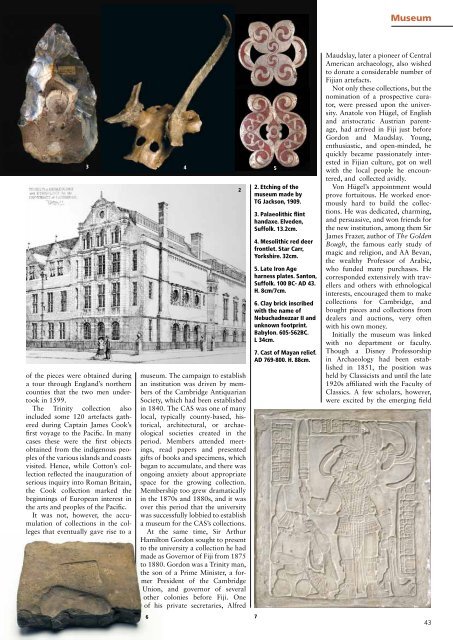Following Odysseus Not the end of the world Amarna city of light ...
Following Odysseus Not the end of the world Amarna city of light ...
Following Odysseus Not the end of the world Amarna city of light ...
- No tags were found...
Create successful ePaper yourself
Turn your PDF publications into a flip-book with our unique Google optimized e-Paper software.
Museum<strong>of</strong> <strong>the</strong> pieces were obtained duringa tour through England’s nor<strong>the</strong>rncounties that <strong>the</strong> two men undertookin 1599.The Trinity collection alsoincluded some 120 artefacts ga<strong>the</strong>redduring Captain James Cook’sfirst voyage to <strong>the</strong> Pacific. In manycases <strong>the</strong>se were <strong>the</strong> first objectsobtained from <strong>the</strong> indigenous peoples<strong>of</strong> <strong>the</strong> various islands and coastsvisited. Hence, while Cotton’s collectionreflected <strong>the</strong> inauguration <strong>of</strong>serious inquiry into Roman Britain,<strong>the</strong> Cook collection marked <strong>the</strong>beginnings <strong>of</strong> European interest in<strong>the</strong> arts and peoples <strong>of</strong> <strong>the</strong> Pacific.It was not, however, <strong>the</strong> accumulation<strong>of</strong> collections in <strong>the</strong> collegesthat eventually gave rise to a3 4museum. The campaign to establishan institution was driven by members<strong>of</strong> <strong>the</strong> Cambridge AntiquarianSociety, which had been establishedin 1840. The CAS was one <strong>of</strong> manylocal, typically county-based, historical,architectural, or archaeologicalsocieties created in <strong>the</strong>period. Members att<strong>end</strong>ed meetings,read papers and presentedgifts <strong>of</strong> books and specimens, whichbegan to accumulate, and <strong>the</strong>re wasongoing anxiety about appropriatespace for <strong>the</strong> growing collection.Membership too grew dramaticallyin <strong>the</strong> 1870s and 1880s, and it wasover this period that <strong>the</strong> universitywas successfully lobbied to establisha museum for <strong>the</strong> CAS’s collections.At <strong>the</strong> same time, Sir ArthurHamilton Gordon sought to presentto <strong>the</strong> university a collection he hadmade as Governor <strong>of</strong> Fiji from 1875to 1880. Gordon was a Trinity man,<strong>the</strong> son <strong>of</strong> a Prime Minister, a formerPresident <strong>of</strong> <strong>the</strong> CambridgeUnion, and governor <strong>of</strong> severalo<strong>the</strong>r colonies before Fiji. One<strong>of</strong> his private secretaries, Alfred6 7252. Etching <strong>of</strong> <strong>the</strong>museum made byTG Jackson, 1909.3. Palaeolithic flinthandaxe. Elveden,Suffolk. 13.2cm.4. Mesolithic red deerfrontlet. Star Carr,Yorkshire. 32cm.5. Late Iron Ageharness plates. Santon,Suffolk. 100 BC- AD 43.H. 8cm/7cm.6. Clay brick inscribedwith <strong>the</strong> name <strong>of</strong>Nebuchadnezzar II andunknown footprint.Babylon. 605-562BC.L 34cm.7. Cast <strong>of</strong> Mayan relief.AD 769-800. H. 88cm.Maudslay, later a pioneer <strong>of</strong> CentralAmerican archaeology, also wishedto donate a considerable number <strong>of</strong>Fijian artefacts.<strong>Not</strong> only <strong>the</strong>se collections, but <strong>the</strong>nomination <strong>of</strong> a prospective curator,were pressed upon <strong>the</strong> university.Anatole von Hügel, <strong>of</strong> Englishand aristocratic Austrian parentage,had arrived in Fiji just beforeGordon and Maudslay. Young,enthusiastic, and open-minded, hequickly became passionately interestedin Fijian culture, got on wellwith <strong>the</strong> local people he encountered,and collected avidly.Von Hügel’s appointment wouldprove fortuitous. He worked enormouslyhard to build <strong>the</strong> collections.He was dedicated, charming,and persuasive, and won fri<strong>end</strong>s for<strong>the</strong> new institution, among <strong>the</strong>m SirJames Frazer, author <strong>of</strong> The GoldenBough, <strong>the</strong> famous early study <strong>of</strong>magic and religion, and AA Bevan,<strong>the</strong> wealthy Pr<strong>of</strong>essor <strong>of</strong> Arabic,who funded many purchases. Hecorresponded extensively with travellersand o<strong>the</strong>rs with ethnologicalinterests, encouraged <strong>the</strong>m to makecollections for Cambridge, andbought pieces and collections fromdealers and auctions, very <strong>of</strong>tenwith his own money.Initially <strong>the</strong> museum was linkedwith no department or faculty.Though a Disney Pr<strong>of</strong>essorshipin Archaeology had been establishedin 1851, <strong>the</strong> position washeld by Classicists and until <strong>the</strong> late1920s affiliated with <strong>the</strong> Faculty <strong>of</strong>Classics. A few scholars, however,were excited by <strong>the</strong> emerging field43
















